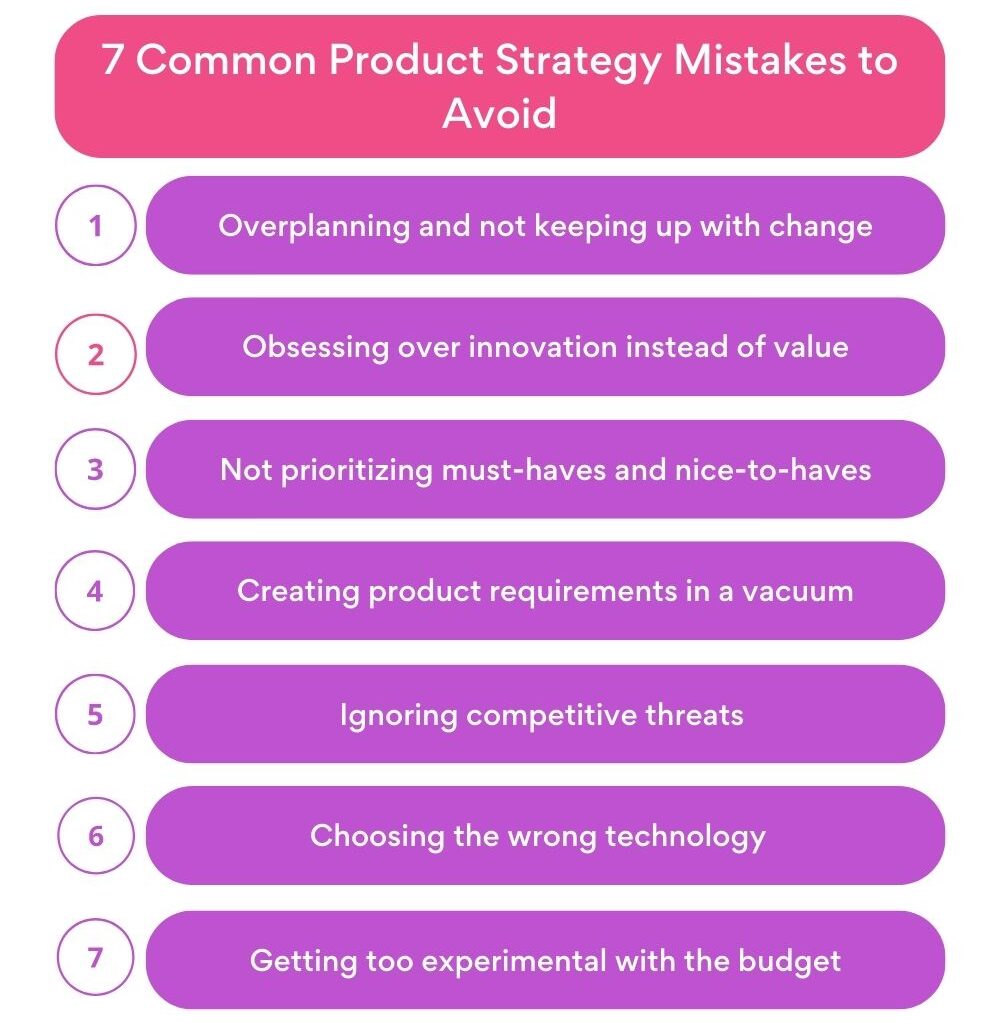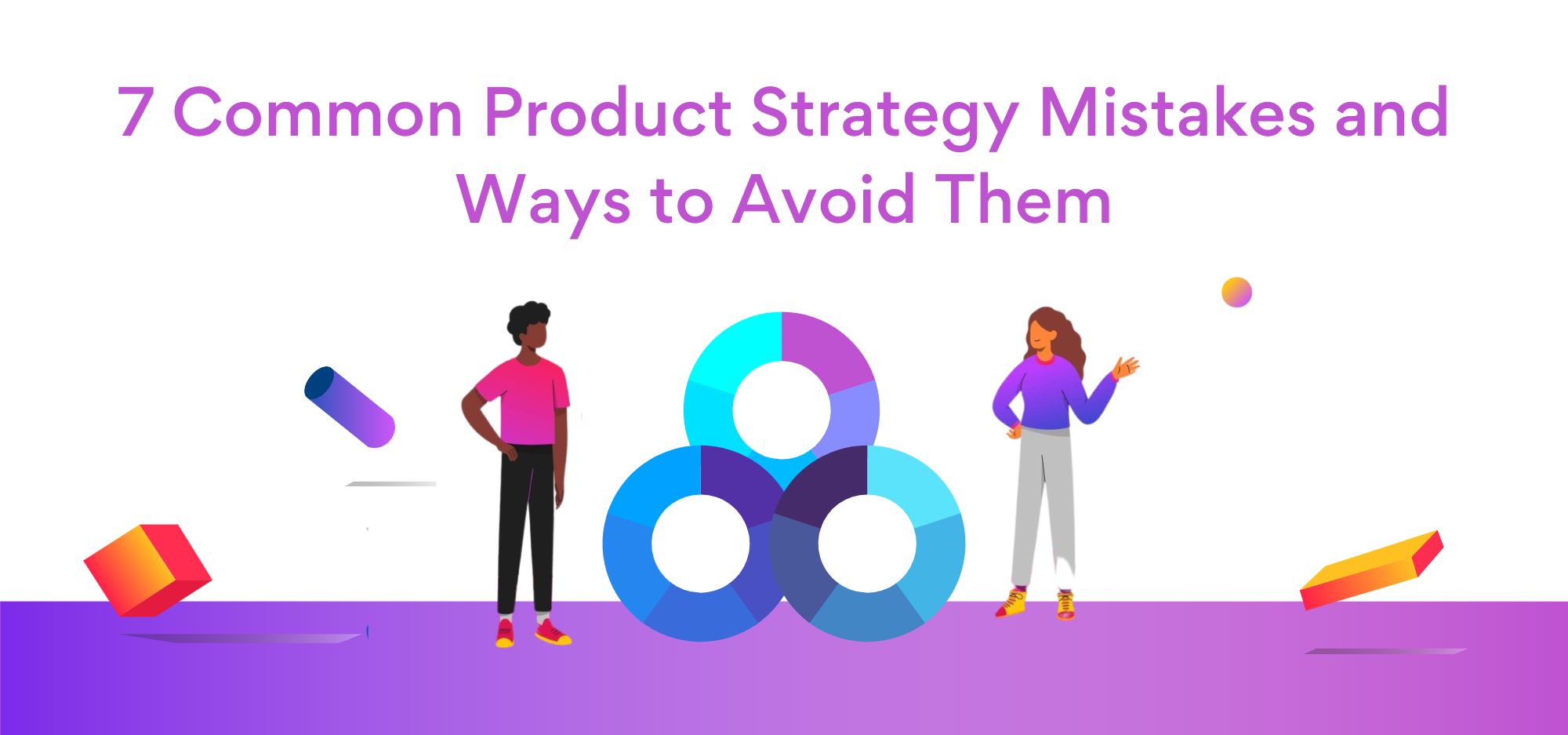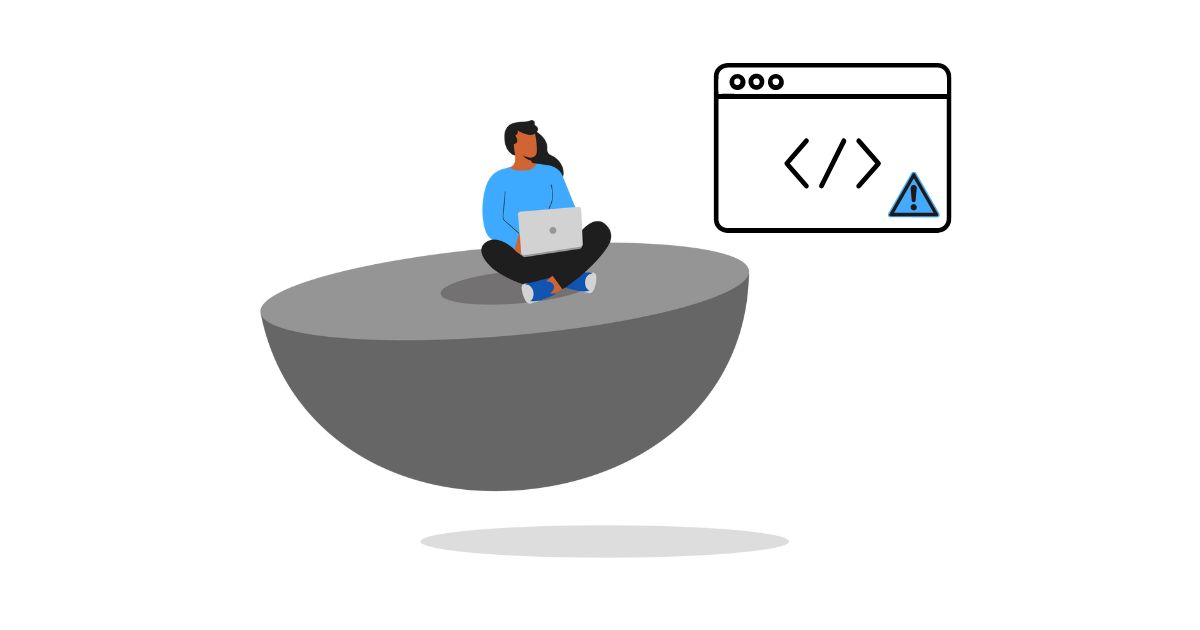Common Product Strategy Mistakes and Ways to Avoid Them
Every successful product is a robust, well-planned product strategy driven by an efficient product team.
In this blog post, we will cover:
What is product strategy?
A product strategy is a high-level plan explaining what a business wants to accomplish through its product and how it plans on doing so. The strategy also answers questions like who the product will serve, i.e., personas, how the product will benefit those personas, and the company’s overall goals for the product through its life cycle.
In other words, product strategy answers the eternal question, “How do I get someone to buy what I am selling?”. A great product strategy can help you develop a great product. But what makes a great product strategy? Keep reading to find out.
Related Post: The Nine Steps of Software Product Development Lifecycle
What are the key components of a product strategy?
Product strategy is a combination of seven key components. They are as follows:
-
Product vision
Product vision is the long-term mission of your product. This mission is typically a concise, aspirational statement that shares what the company wants the product to achieve. Therefore, a product vision must remain static. To build and release a great product, you need a strong product vision. A good vision encompasses who your customers are, what they need, and your go-to-market plan. In addition, it highlights the opportunities and threats in your way. -
Product goals
A product vision should ideally lead to strategic product goals with measurable results that you can achieve within specific timeframes. These goals will determine what the team prioritizes on the product roadmap. Your product goals should be trackable, so you know how your team performs against them. You can use the SMART approach when setting goals for your product strategy. This approach helps you set specific, measurable, attainable, relevant, and time-bound goals.
Here are a few examples of product goals:
- Increase free-trial downloads by 50 percent in the next six months
- Improve average customer rating by one star on major product-review sites
- Generate $5M in revenue within 12 months
- Expand business to three new countries within 24 months
- Increase free-trial downloads by 50 percent in the next six months
-
Initiatives
Initiatives are critical, complex objectives you must break down into actionable tasks. Initiatives enable you to identify key tasks you must complete to achieve your product’s goals. Think of initiatives as projects that you should accomplish within a fixed timeframe. In other words, initiatives are strategic themes you derive from your product goals and add to your roadmap. Remember, your product initiatives should always align with your company’s strategy.
Examples of product initiatives include:
- Improve customer satisfaction
- Increase lifetime customer value
- Enhance UI
- Reduce churn rate
- Sustain product features
- Prioritize language localization
- Improve customer satisfaction
-
Customers
The foundation of every product strategy is customers. Your product is designed to satisfy them. And without customers, your product may be rendered useless.
So be sure to create different customer profiles for different products while building product strategy. To create a customer profile, you must gather all the data of customers who purchased similar products and the channels they frequently visit.
Leave out no details when defining your target customers. Dig deep and acquire as many insights as possible. Collecting these insights under a single customer profile enables you to clearly understand who you’re selling to. By creating in-depth customer profiles, you can build products that meet their needs and use marketing channels that increase your chances of sales. -
Competitors
Now that you’ve identified your customers, it’s time to look at the competitors targeting them. You may have direct competitors (for example, Coke and Pepsi) or indirect competitors (for example, Airbnb and Hilton) for your product. You must identify these competitors and analyze their strengths and weaknesses. Try to understand their product strategy as best as your can. Examine their product positioning, packaging, market share, etc.
By conducting a detailed analysis of your competitor’s products, you can create a product strategy that leverages market opportunities your competitor could not capitalize on. -
Business goal
Every business has a fundamental goal: earn profit. Naturally, your company’s shareholders expect you to earn profit and provide a return on investment. The higher, the better. So your product strategy must align with the business goal of shareholders and top management executives. Simply put, your strategy should ensure that the product you’re developing will get them a return on investment.
You must also think about how the customers will consume the product. Is it only a one-time purchase? Or will consumers want to buy it repeatedly? Or is it something you subscribe to? Basically, your product strategy must explain how you will sell the product and how customers will consume it. -
Macro environment
Macro environment refers to the current state of economics, politics, culture, and technology that affects customers’ buying and selling habits. Therefore, product managers must carefully analyze the macro environment before creating a product strategy.
By analyzing buying and selling trends, you can take advantage of existing opportunities and extend the product life cycle. Your product strategy should account for the following factors:- Emerging markets where your product may have demand
- Emerging technologies that may impact your customers
- Economic forces that may impact your customers’ budgets or needs
- Evolving customer needs and behaviors
Common product strategy mistakes

7 Common Product Strategy Mistakes to Avoid
Now that we’ve covered the crucial components of product strategy, let’s take a look at the most common product strategy mistakes companies.
-
Planning for too long and not keeping up with change
One of the most common yet grave mistakes companies make is planning for too long before implementing a product strategy. Sure, planning is a critical part of product development. Diving into development prematurely, before defining the product, is a serious product strategy pitfall. But if you take too long to get started, your idea may never turn into a product. Furthermore, the market conditions may have already changed till you implement your strategy.
Similarly, if you view the product strategy as a one-time, static plan instead of a constantly evolving one, you will be left scrambling to keep up with trends. Not keeping the product strategy up-to-date can cost you significantly.
Related Post: 7 Best Software Development Lifecycle Management Methods
Ways to avoid this mistake
Waiting for the ‘right time’ may not always be the best idea for your product. The longer you sit with your idea, the more difficult it becomes to define a functional framework and make a compelling business case. Rapid prototyping, releasing a decent minimum viable product, and building and iterating off of your learnings are great ways to ensure your product moves out of the development phase.
Don’t view your product strategy as a fixed plan that needs one-time execution. You must tweak and adapt the strategy as the product grows and markets evolve. Review it once every three months to ensure the strategy says relevant. You must constantly upgrade your product with the changing market conditions. Adopting a work-as-you-go approach allows you to change your strategy with changing market conditions and create a solid product. -
Obsessing over innovation instead of value
As a product leader or manager, you will want your product to deliver high functionality. But don’t let that hyperfocus on functionality come at a high price. While you’re obsessing over building a seamless product, your user is looking at its benefits. They’re thinking about how the product will help them.
And so your product must offer a clear value to that market. It must solve a problem. Just because you can include certain features in your product doesn’t mean you should.
Related Post: 7 Ways Managers Can Boost Remote Workers’ Productivity
Ways to avoid this mistake
Don’t let your drive for innovation overshadow your value proposition. Observe, analyze, and understand the target market first. What do your customers want? Work toward creating that value at every step of the product development process. Everything you do should enhance the value of the product. If it’s not adding value, don’t do it. When you drive decisions through this value-added framework, your product succeeds, and end users benefit.
Remember, it’s not about what you want customers to have. It’s about what customers want. -
Not prioritizing must-haves and nice-to-haves
Here’s the thing: you cannot implement every feature on the roadmap in the initial version of your product. To get to the market quickly, you must prioritize your features. The vital features of your product — the ones that you must implement before it goes to market — must be built out first.
But this is easier said than done. Product teams are often confused over which features are must-haves and which are nice-to-haves.
Related Post: 25 Habits to Become An Effective Manager
Ways to avoid this mistake
Build a classification system for prioritizing features. Coordinate with your project team to determine which features are critical to include versus features your product can succeed without.
As product requirements become clearer, prioritize releasing a minimum viable product (MVP) and building and iterating based on your learnings. A core benefit of developing an MVP is that it enables you to test your business concepts. This ensures your project doesn’t get stuck in development.
Ensure you release an MVP that has enough value for early users, demonstrates future benefits, and contains a feedback loop for future development. This process lets you understand what users want and improve the next version of your product based on real data. -
Creating product requirements in a vacuum
One of the most common product strategy mistakes is crafting requirements in a vacuum. When building a product strategy, gathering the right input from everyone involved is critical. By not involving necessary people in product development, product managers miss out on new perspectives and opinions vital for creating good products. They also overlook the needs of certain stakeholders.
Moreover, if the team does not have an expert for each product function, managers are forced to rely on a few individuals to bring expertise in all the areas relevant to product strategy.
Related Post: 6 Tips to Scale A Design Team: A Guide for Product Managers
Ways to avoid this mistake
Thankfully, this mistake is easy to fix. Take an integrated approach to product strategy by involving product owners, UI/UX designers, developers, engineers, and architects, in the product strategy.
By keeping the team diverse, you can get valuable input and cover all bases to help you create a successful product. Embracing an inclusive process at this stage ensures that you consider user experience from all angles before your product launch.
Related Post: 6 Challenges to Remote Hiring and How to Overcome Them -
Ignoring competitive threats
Some companies want to build a product simply because their competitor has one, whereas some are completely unaware of what the competition is doing. Both approaches can lead to severe consequences. Not monitoring competition and emerging trends can be a grave mistake while building a product strategy.
Your competitors may launch products that rival your own with features that are a little too similar. Keep a close watch on such developments.
Ways to avoid this mistake
Have a clear understanding of your product’s positioning and place in your niche. Ensure you know who your key competitors are. With the right competitive research, you can define your product’s unique value proposition and optimize user lifetime value over time. Think of how you can differentiate your product in the market. Just because your competitor does something doesn’t mean you should.
Ask yourself these questions:
- What makes your product different?
- Why do customers want your product?
- What problems does your product solve?
- How does your product help you meet your company’s goals?
Failing to address these questions can make your product redundant or irrelevant. Therefore, conduct a thorough competitor analysis to set your product apart.
- What makes your product different?
-
Choosing the wrong technology
If you choose the wrong tech stack for your product, chances are that you will have to build your product again. Choosing the wrong technology for your product can cost you money, time, and resources.
For example, you create a product for a small user base. However, when the product enters the market, the user base increases. If the tech stack does not support the growing user base, the product is likely to fail.
Ways to avoid this mistake
Ensure the technology you choose is suitable for your project and your business needs. Consider what you want to achieve and how the technology corresponds to your business objectives.
Ascertain that the technology you want to use is showing an upward trend because technologies with a downward trend may hamper the development process and the maintenance of your product.
While building a digital product, you must research different tech stacks suitable and choose the one that meets all your existing and future requirements. Key factors in choosing the right tech stack include product functions, system load requirements, scalability, and security, among others. -
Experimenting with the budget excessively
Going overboard with the budget is a common but often ignored product strategy mistake. Businesses require stability to grow consistently. Therefore, constantly experimenting with the budget may not be a good idea. After working on a strong go-to-market product strategy, product managers must ensure they utilize the budget efficiently.
Ways to avoid this mistake
Use your budget for hiring the right resources and decide how many beta versions of the product you can afford to make and release.
Calculate the cost of incorporating different functions for your product and the current market rate of professionals with different skills. After that, you can decide the upper and lower limit of how much you can spare for different resources without spending more than the allocated budget.
Summary
While a solid product strategy does not guarantee market success, it eases the process of getting there. By avoiding common product strategy mistakes, you can create robust products that are ready for the market.
Are you struggling with product strategy? Try Turing. Turing specializes in delivering end-to-end product development services to aid businesses achieve operational excellence. Visit the page to know more!
FAQs
What are the three types of product strategies?
The three types of product strategies include comparative positioning strategy, differentiation, and segmentation. In the comparative positioning strategy, brands place their products right next to the competitor products to show better pricing. Differentiation strategy highlights the differences in the product when compared to another brand, whereas segmentation diversifies product packaging into different forms like small packets, bottles, and cans.
Tell us the skills you need and we'll find the best developer for you in days, not weeks.












